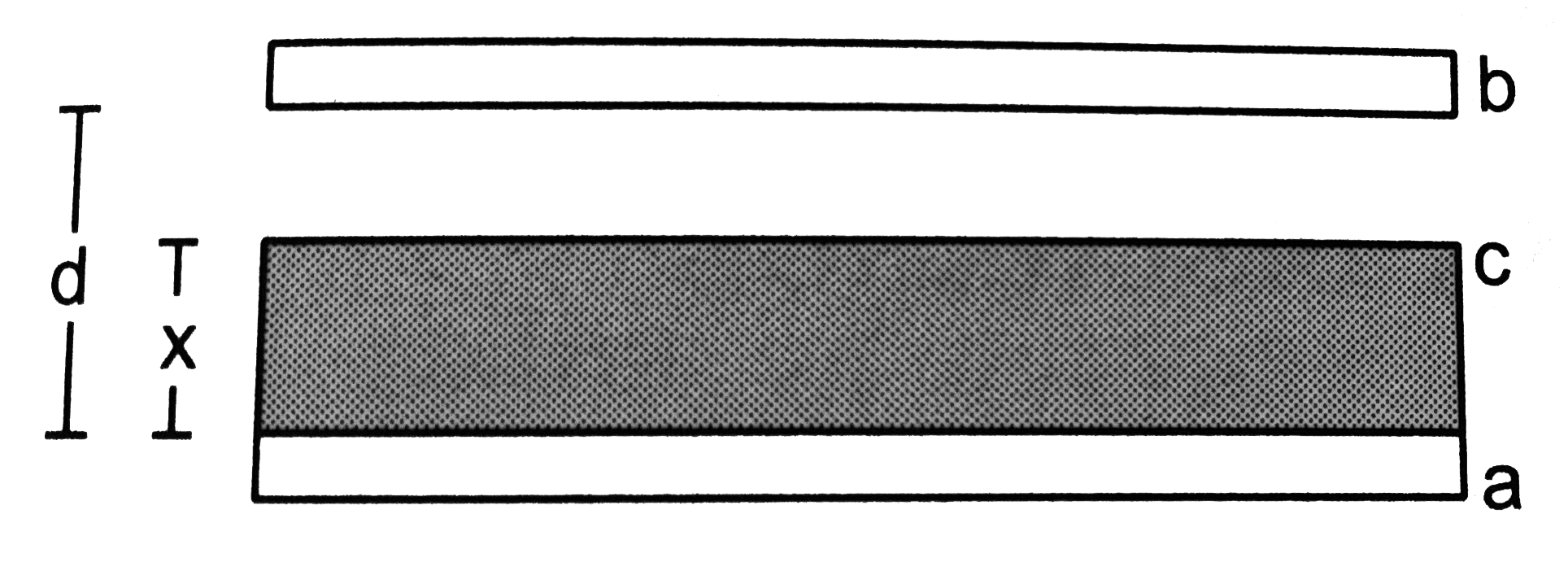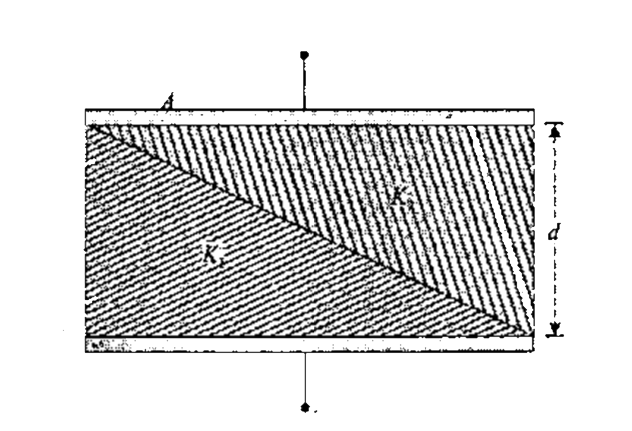The two parallel plates of a capacitor have equal and opposite charges Q. The dielectric (which is filled between the capacitor plates) has a dielectric constant K and resistivity ρ . Show that the initially "leakage" current carried by the dielectric is given by the relationship i=QK∈0ρ.
To solve the problem, we need to derive the expression for the leakage current i in a capacitor with a dielectric material. The dielectric has a dielectric constant K and resistivity ρ. The charge on the capacitor plates is Q.
1. Understand the Concept of Leakage Current:
- The leakage current in a capacitor occurs due to the resistive properties of the dielectric material. Even though dielectrics are typically insulators, they can allow some current to flow due to their resistivity.
Hint: Remember that leakage current is a result of the dielectric's resistivity.
2. Capacitance of the Capacitor:
- The capacitance C of a parallel plate capacitor filled with a dielectric is given by:
C=Kϵ0Ad
where K is the dielectric constant, ϵ0 is the permittivity of free space, A is the area of one of the plates, and d is the separation between the plates.
Hint: Identify the variables in the capacitance formula.
3. Resistance of the Dielectric:
- The resistance R of the dielectric can be expressed in terms of its resistivity ρ:
R=ρLA
where L is the thickness of the dielectric (which can be taken as d in this case).
Hint: Relate resistance to resistivity and dimensions of the dielectric.
4. Time Constant τ:
- The time constant τ for the charging process of the capacitor is given by:
τ=RC
Substituting the expressions for R and C:
τ=(ρdA)(Kϵ0Ad)=Kϵ0ρ
Hint: Combine the expressions for R and C to find the time constant.
5. Expression for Current:
- The current i(t) during the charging of the capacitor can be expressed as:
i(t)=QRCe−tRC
Substituting RC with Kϵ0ρ:
i(t)=QKϵ0ρe−tKϵ0ρ
Hint: Use the relationship between current, charge, and time constant.
6. Initial Condition:
- To find the initial leakage current, we set t=0:
i(0)=QKϵ0ρe0=QKϵ0ρ
Hint: Evaluate the expression at t=0 to find the initial current.
7. Final Result:
- Thus, the initially leakage current carried by the dielectric is given by:
i=QKϵ0ρ
Conclusion:
We have derived the expression for the leakage current in a capacitor with a dielectric material. The key steps involved understanding the capacitance, resistance, and the time constant of the system.
- The leakage current in a capacitor occurs due to the resistive properties of the dielectric material. Even though dielectrics are typically insulators, they can allow some current to flow due to their resistivity.
- The capacitance C of a parallel plate capacitor filled with a dielectric is given by:
C=Kϵ0Ad
where K is the dielectric constant, ϵ0 is the permittivity of free space, A is the area of one of the plates, and d is the separation between the plates.
- The resistance R of the dielectric can be expressed in terms of its resistivity ρ:
R=ρLA
where L is the thickness of the dielectric (which can be taken as d in this case).
- The time constant τ for the charging process of the capacitor is given by:
τ=RC
Substituting the expressions for R and C:
τ=(ρdA)(Kϵ0Ad)=Kϵ0ρ
- The current i(t) during the charging of the capacitor can be expressed as:
i(t)=QRCe−tRC
Substituting RC with Kϵ0ρ:
i(t)=QKϵ0ρe−tKϵ0ρ
- To find the initial leakage current, we set t=0:
i(0)=QKϵ0ρe0=QKϵ0ρ
- Thus, the initially leakage current carried by the dielectric is given by:
i=QKϵ0ρ
We have derived the expression for the leakage current in a capacitor with a dielectric material. The key steps involved understanding the capacitance, resistance, and the time constant of the system.
Topper's Solved these Questions
- CAPACITANCEBOOK - RESONANCE ENGLISHCHAPTER - CAPACITANCEEXERCISE - Exercise - 2
74 Videos
- CAPACITANCEBOOK - RESONANCE ENGLISHCHAPTER - CAPACITANCEEXERCISE - Exercise - 3
26 Videos
- CAPACITANCEBOOK - RESONANCE ENGLISHCHAPTER - CAPACITANCEEXERCISE - Miscellaneous Solved Example
3 Videos
- ATOMIC PHYSICSBOOK - RESONANCE ENGLISHCHAPTER - ATOMIC PHYSICSEXERCISE - Advanved level problems
17 Videos
- COMMUNICATION SYSTEMSBOOK - RESONANCE ENGLISHCHAPTER - COMMUNICATION SYSTEMSEXERCISE - Exercise 3
13 Videos
Similar Questions
A parallel plate air capacitor has a capacitance of 5μF. It becomes 50μF when a dielectric medium occupies the entire space between its two plates. What is the dielectric constant of the medium ?
View SolutionWhen a parallel plate capacitor is filled with wax after separation between plates is doubled, its capacitance becomes twice. What is the dielectric constant of wax?
View Solution
Knowledge Check
A parallel plate air capacitor has a capacitance C. When it is half filled with a dielectric of dielectric constant 5, the percentage increase in the capacitance will be
A400%B66.6%C33.3%D200%
A parallel plate capacitor has plate area A and plate separation d. The space betwwen the plates is filled up to a thickness x (ltd) with a dielectric constant K. Calculate the capacitance of the system.

View SolutionA parallel plate air capacitor has capacitance C. Half of space between the plates is filled with dielectric of dielectric constant K as shown in figure . The new capacitance is C . Then

View SolutionA parallel plate capacitor has a dielectric (of dielectric constant k) between the plates. The plates are charged to a surface charge density σ0. What is the density of the polarized charge that appear on the surface of the dielectric.
View SolutionIn a parallel-plate capacitor, the region between the plates is filled by a dielectric slab. The capacitor is connected to a cell and the slab is taken out. Then
View SolutionThe capacitance of a parallel plate capacitor with plate area A and separation d is C. The space between the plates in filled with two wedges of dielectric constants K1 and K2 respectively. Find the capacitance of resulting capacitor.

View SolutionA parallel plate air-core capacitor is connected across a source of constant potential difference. When a dielectric plate is introduced between the two plates then:
View SolutionA dielectric slab is inserted between the plates of a capacitor. The charge on the capacitor is Q and the magnitude of the induced charge on each surface of the dielectric is Q'.
View Solution
